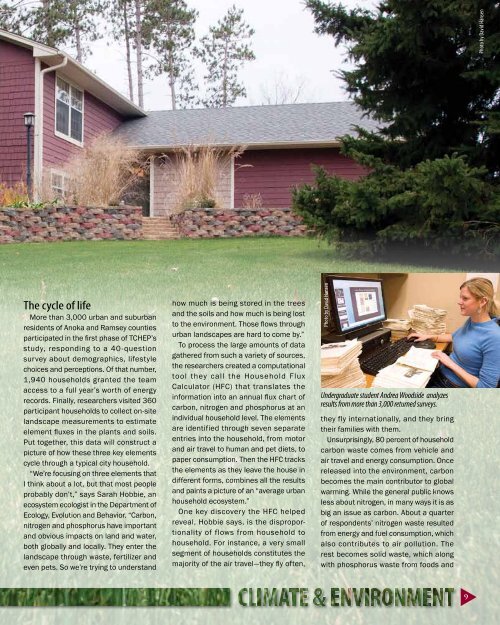PDF Version - College of Food, Agricultural and Natural Resource ...
PDF Version - College of Food, Agricultural and Natural Resource ...
PDF Version - College of Food, Agricultural and Natural Resource ...
You also want an ePaper? Increase the reach of your titles
YUMPU automatically turns print PDFs into web optimized ePapers that Google loves.
The cycle <strong>of</strong> life<br />
More than 3,000 urban <strong>and</strong> suburban<br />
residents <strong>of</strong> Anoka <strong>and</strong> Ramsey counties<br />
participated in the first phase <strong>of</strong> TCHEP’s<br />
study, responding to a 40-question<br />
survey about demographics, lifestyle<br />
choices <strong>and</strong> perceptions. Of that number,<br />
1,940 households granted the team<br />
access to a full year’s worth <strong>of</strong> energy<br />
records. Finally, researchers visited 360<br />
participant households to collect on-site<br />
l<strong>and</strong>scape measurements to estimate<br />
element fluxes in the plants <strong>and</strong> soils.<br />
Put together, this data will construct a<br />
picture <strong>of</strong> how these three key elements<br />
cycle through a typical city household.<br />
“We’re focusing on three elements that<br />
I think about a lot, but that most people<br />
probably don’t,” says Sarah Hobbie, an<br />
ecosystem ecologist in the Department <strong>of</strong><br />
Ecology, Evolution <strong>and</strong> Behavior. “Carbon,<br />
nitrogen <strong>and</strong> phosphorus have important<br />
<strong>and</strong> obvious impacts on l<strong>and</strong> <strong>and</strong> water,<br />
both globally <strong>and</strong> locally. They enter the<br />
l<strong>and</strong>scape through waste, fertilizer <strong>and</strong><br />
even pets. So we’re trying to underst<strong>and</strong><br />
how much is being stored in the trees<br />
<strong>and</strong> the soils <strong>and</strong> how much is being lost<br />
to the environment. Those flows through<br />
urban l<strong>and</strong>scapes are hard to come by.”<br />
To process the large amounts <strong>of</strong> data<br />
gathered from such a variety <strong>of</strong> sources,<br />
the researchers created a computational<br />
tool they call the Household Flux<br />
Calculator (HFC) that translates the<br />
information into an annual flux chart <strong>of</strong><br />
carbon, nitrogen <strong>and</strong> phosphorus at an<br />
individual household level. The elements<br />
are identified through seven separate<br />
entries into the household, from motor<br />
<strong>and</strong> air travel to human <strong>and</strong> pet diets, to<br />
paper consumption. Then the HFC tracks<br />
the elements as they leave the house in<br />
different forms, combines all the results<br />
<strong>and</strong> paints a picture <strong>of</strong> an “average urban<br />
household ecosystem.”<br />
One key discovery the HFC helped<br />
reveal, Hobbie says, is the disproportionality<br />
<strong>of</strong> flows from household to<br />
household. For instance, a very small<br />
segment <strong>of</strong> households constitutes the<br />
majority <strong>of</strong> the air travel—they fly <strong>of</strong>ten,<br />
Photo by David Hansen<br />
Undergraduate student Andrea Woodside analyzes<br />
results from more than 3,000 returned surveys.<br />
they fly internationally, <strong>and</strong> they bring<br />
their families with them.<br />
Unsurprisingly, 80 percent <strong>of</strong> household<br />
carbon waste comes from vehicle <strong>and</strong><br />
air travel <strong>and</strong> energy consumption. Once<br />
released into the environment, carbon<br />
becomes the main contributor to global<br />
warming. While the general public knows<br />
less about nitrogen, in many ways it is as<br />
big an issue as carbon. About a quarter<br />
<strong>of</strong> respondents’ nitrogen waste resulted<br />
from energy <strong>and</strong> fuel consumption, which<br />
also contributes to air pollution. The<br />
rest becomes solid waste, which along<br />
with phosphorus waste from foods <strong>and</strong><br />
9<br />
Photo by David Hansen

















